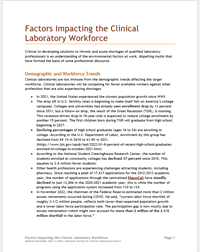Position
Ensuring access to quality health care services demands that the health care system have an adequate supply of clinical laboratory technologists and technicians. Today the pool is already seriously short of what is needed and is estimated to become critical as the U.S. population ages. This shortage hampers the ability of clinical laboratories to meet the growing need for appropriate testing, impeding the ability of clinicians to diagnose and treat patients. An ever-increasing patient population and the number and complexity of medical laboratory tests strain the profession. The coronavirus (COVID-19) pandemic has heightened these concerns as workload increases lead to burnout for some laboratory personnel.
We call upon Congress to:
- Support Section 212 of the Bipartisan Primary Care and Health Workforce Act (S.2840) to address the clinical laboratory and allied health workforce. Specifically, Section 212 would authorize funding for a workforce innovation grant program within the Health Resources and Services Administration (HRSA) of the U.S. Department of Health and Human Services for community health centers and rural health clinics to carry out innovative, community-driven models to educate and train a wide range of allied health professionals, such as medical laboratory technicians and technogists. These grants would include partnerships with high schools, community colleges, and other entities.
- Establish a program of scholarships and loan repayment, similar but distinct from the National Health Service Corp, to alleviate the shortage of clinical laboratory personnel. The scholarship and loan repayment program shall include a period of obligated service for recipients in a designated health professional shortage area.
- Establish a federal grant program to assist allied health schools in recruiting and retaining clinical laboratory students to improve the availability of these professionals throughout the U.S. Such grants will also help programs recruit necessary faculty and provide clinical training required to enter the profession.
Background
The Bureau of Labor Statistics (BLS) within the U.S. Department of Labor estimates that the current clinical laboratory workforce of technologists and technicians is 335,500. The estimated demand for these professionals will grow by 11 percent between 2020 and 2030.
Representing nearly 1/3 of the health care workforce, allied health occupations have not received the focus and attention from the Congress that physicians and nurses have over the past several decades. High skill occupations, like medical laboratory technicians and technologists, are essential for the operation of our U.S. health and public health systems and significant shortages in these allied health occupations persist. This legislation represents an acknowledgement of the vital roles allied health professionals play in these systems.
The National Health Service Corp (NHSC) program exists today to place physicians, advanced practice nurses, mental health providers, and oral health providers in underserved rural and urban communities. These placements have assisted underserved populations in receiving necessary care. Clinical laboratory professionals are not eligible for this program today. Rather than amend the NHSC to include laboratory professionals, we urge Congress to authorize a similar program alongside the NHSC to address the need for laboratory professionals in these underserved communities.
Federal grant programs exist today within schools of nursing and medicine to address the recruitment and retention of students in these professions. No such program exists for clinical laboratory professionals. Such a program would be valuable in helping allied health schools recruit and retain students, recruit necessary faculty, and provide clinical training required for students to enter the profession rapidly.
More than 4 billion medical laboratory tests are performed yearly in the United States, the single highest volume of medical activity. Laboratory test data influence approximately 70 percent of physicians’ patient interactions.
Please contact Patrick Cooney at 202-413-2629 or via email at patrick@federalgrp.com if you have any questions regarding this issue brief.
